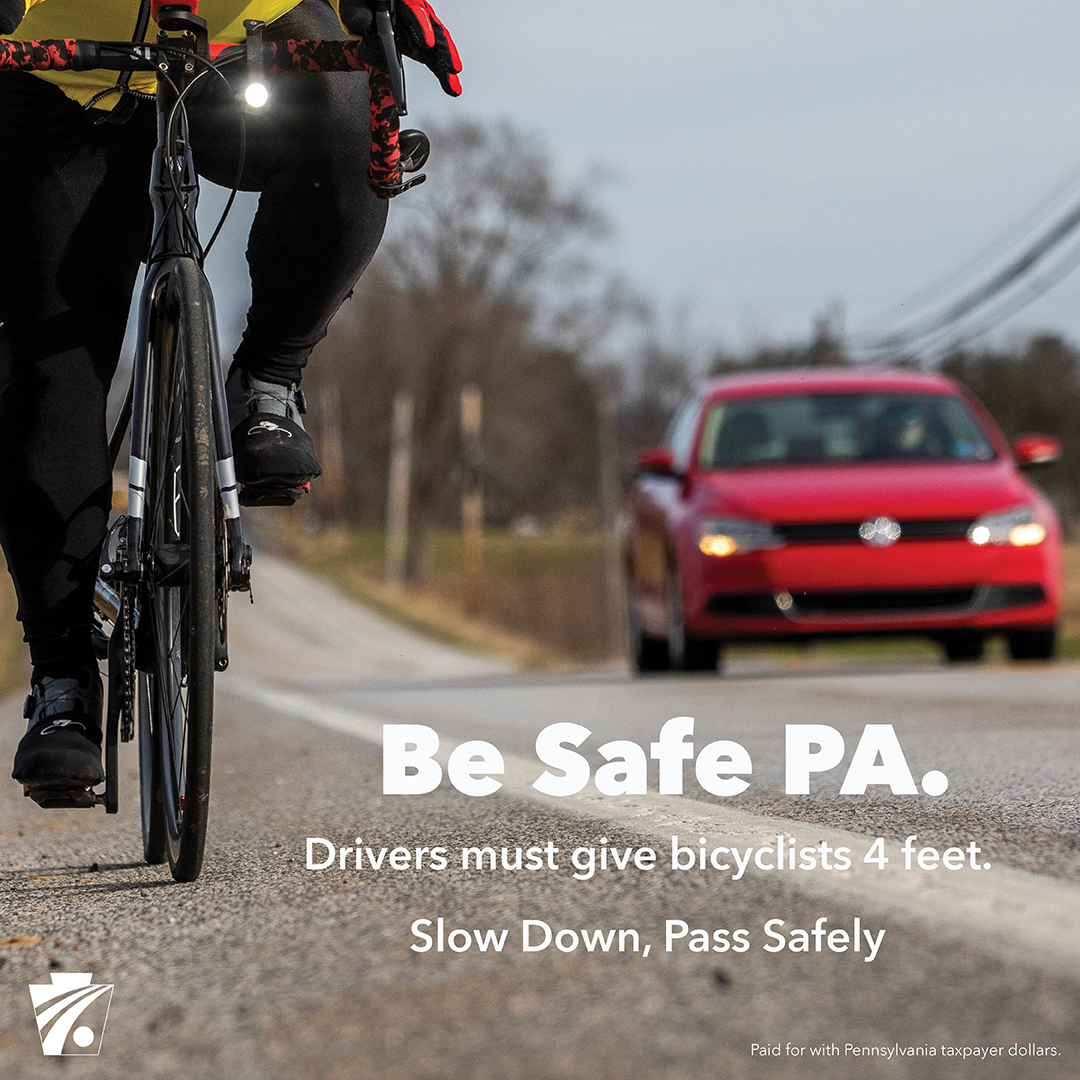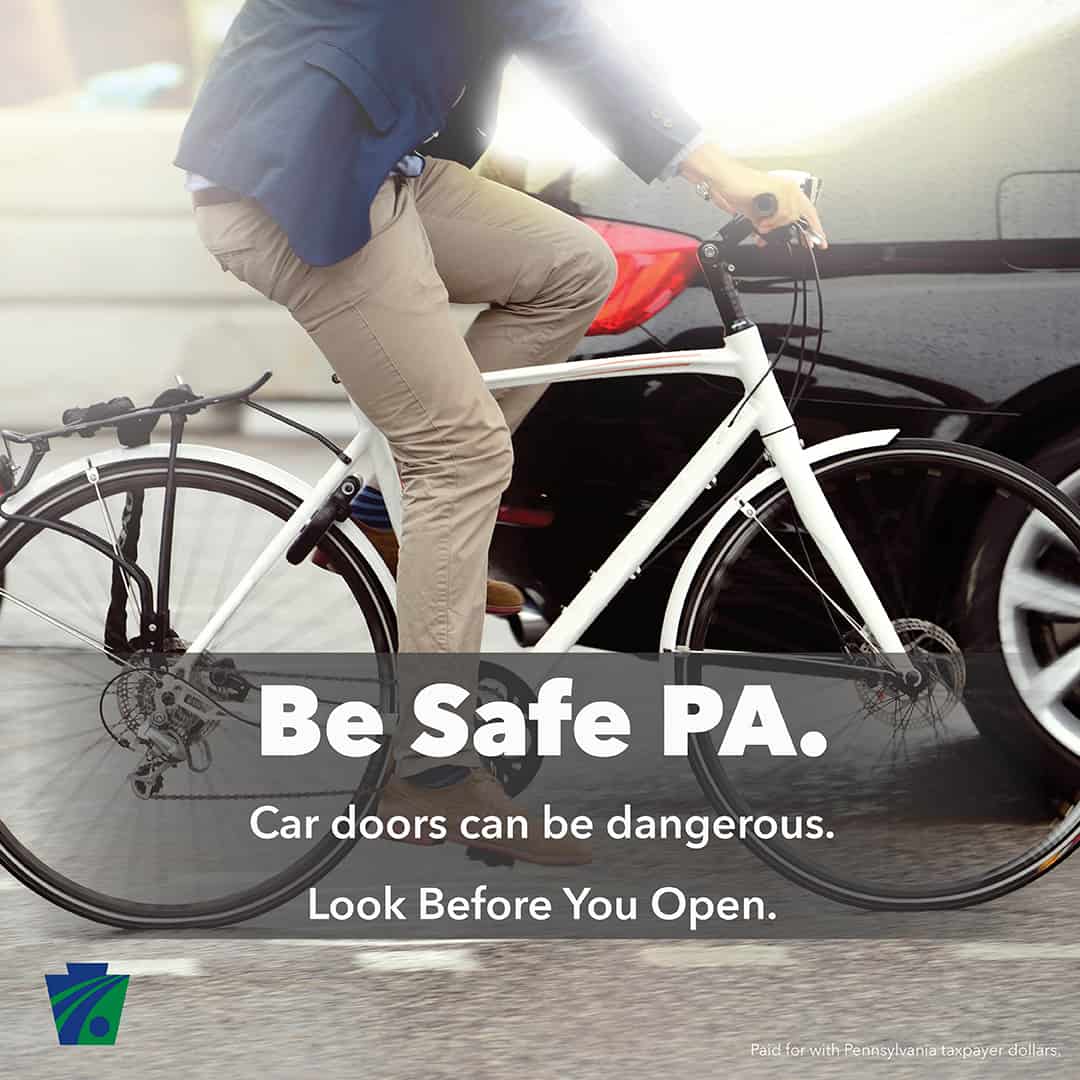Bicycle Safety and Pennsylvania Laws
When you're commuting on your bike, you're likely to share the road with cars. If you know the laws, safety rules, and have the right attitude, you can be a confident, streetwise cyclist.
General Bicycle Law
Pennsylvania's Vehicle Code considers "pedalcycles" as vehicles and provides that every person riding a pedalcycle upon a roadway shall be granted all of the rights and responsibilities applicable to a driver of a vehicle, with certain exceptions discussed below.
If you ride in violation of the traffic laws, you greatly increase your risk of a crash and will likely be found at fault in the event of an accident.
Riding on the Roadway
- Bikes may be ridden on the shoulder of the road (in the same direction as the flow of traffic) but are not required to do so.
- Bikes may also ride on the right half of the roadway as follows:
- On a multilane roadway, bikes may be ridden in the right-most travel lane.
- On a two-lane roadway, a bike may be ridden in the right lane.
- On a roadway with no center line, a bike may be ridden anywhere on the right side of the roadway.
- Bikes may move from the right lane:
- When overtaking another vehicle proceeding in the same direction.
- When preparing to make a left turn.
- When an obstruction exists that makes it necessary to change lanes or cross the center line with due care.
- Persons riding bicycles upon a roadway shall not ride more than two abreast (side-by-side), unless on paths or parts of a roadway set aside for exclusive use of bicycles.
- A bicycle or motor vehicle may, with good caution, treat an intersection with an inoperable or malfunctioning traffic signal as a stop condition when red or as a caution condition when green or yellow.
- Often signals with embedded detectors will not respond to the bike awaiting a green light, and this is treated as "inoperable" under law.

- Motor vehicles must allow 4 feet of distance when overtaking a bicycle and travel at a careful and prudent speed. It is the motorist’s responsibility to provide this distance, not that of the cyclist.
- Motor vehicles may also overtake a bicycle in a no-passing zone to avoid excessive delays, but this must be done with due care and while providing the required 4 feet of clearance.

- No person shall open any door on a motor vehicle unless and until it is reasonably safe to do so and can be done without interfering with traffic flow.
- Cyclists may be injured or killed when a door is opened in their line of travel (dooring). Therefore, a distance of 4 feet should be kept between parked motor vehicles and the line of travel when riding along parked vehicles.
How to Ride
Riding a bicycle on a roadway with larger, faster-moving vehicles requires prudence and confidence. As a vehicle, you have a right to ride on the shoulder or the appropriate travel lane, and you will need to assert that right by using lane control.
Placing your vehicle appropriately (taking the center of the rightmost travel lane) can greatly reduce your chances of being struck as you are more visible, acting predictably (like another vehicle), and requiring motor vehicles to fully change lanes when overtaking.
Three particular crash types are manageable with lane control:
- Right-Hook Crashes — Overtaking motor vehicles fail to complete the overtaking maneuver safely before initiating the right turn. This results in the cyclist (who is proceeding straight ahead) being struck.
- Dooring — When a driver or passenger of a stopped motor vehicle opens a door into the path of a cyclist without exercising due care.
- Overtaking Crashes — The driver of a motor vehicle fails to overtake with due care and strikes the cyclist from behind.
Current motor vehicle code allows driver to overtake people riding in bike lanes even in no-passing zones if done with due care. Therefore, there is never a reason for bicyclists to encourage a motor vehicle to "squeeze by" in the same travel lane as even a 16-foot lane does not allow for the 4 feet of required clearance.
Equipment
- If you use your bike between sunset and sunrise, it must be equipped with a front lamp and rear and side reflectors that are visible from at least 500 feet. This is both to help other motorists see you and also to illuminate your path.
- Your bike must be equipped with brakes that will stop the bike 15 feet from an initial speed of 15 mph on dry, level pavement.
- Some municipalities require the bike to be equipped with a bell or equivalent signal device.
Sidewalks
- Pedestrians have the right-of-way on sidewalks and bicycle paths. You must give an audible signal as you approach and pass a pedestrian.
- Automobiles are not required to yield to bicycles being ridden across a crosswalk (at a trail crossing for example) as the bicycle is treated as a vehicle. A better choice is to dismount and walk your bike across.
- You are not permitted to ride a bicycle on a sidewalk in a business district (except where permitted by official traffic control devices) or where there is a bicycle-only lane available.
Parking
- You can park your bicycle on a sidewalk as long as it does not impede pedestrian traffic.
- You can park your bicycle at the curb or edge of the roadway where parking is allowed as long as it does not obstruct other vehicles.
Helmets
- Anyone under the age of 12 must wear a helmet when riding a bicycle. This applies to anyone operating the bicycle, riding as a passenger, or riding in an attached restraining seat or trailer. The Pennsylvania Department of Transportation strongly recommends that all bicyclists wear helmets whenever they ride.
Freeways
- Bicycles are not permitted on freeways in Pennsylvania without permission of the Pennsylvania Department of Transportation. A freeway is the general term that denotes a divided highway with complete control of access, which means there are no pedestrians, bikes, horses, signals or intersections. Cars also tend to yield from on-ramps and there are generally no tolls.
Traffic Signals
- All traffic signals must be obeyed in accordance with standard vehicle laws. If a traffic signal does not detect your bicycle, try positioning the bicycle directly over the saw cuts in the pavement that detect vehicles. If the signal still does not detect you, you may treat the red signal as a stop sign and proceed through the intersection after yielding to all intersecting traffic (including pedestrians).
Hand and Arm Signals
- To signal a left turn, extend the left hand and arm horizontally.
- To signal a right turn, extend the right hand and arm horizontally, or extend your left hand and arm upward.
- To signal a stop or decrease in speed, extend the left hand and arm downward.
Bicycling Safety Recommendations
- Always wear a helmet. Pennsylvania law requires all cyclists under age 12 to wear an approved bicycle helmet.
- Obey traffic laws.
- Obey stop signs and red lights.
- Never ride against the flow of traffic.
- Be predictable:
- Ride in a straight line with at least one hand on the handlebars.
- Check to be sure your path is clear, and change directions without swerving.
- Use hand signals to indicate when you are turning.
- Make yourself visible:
- Consider wearing bright cycling clothes.
- Put reflectors on your wheels and on the front and rear of your bike.
- At night, a front light and rear reflector are required.
- Maintain your bike:
- Carry a pump, a patch kit and a spare tube.
- Take care of yourself:
- Carry plenty of drinking water and snacks for energy.
- Bring your cellphone in case of an emergency.
For more information on biking safety, visit the
League of American Bicyclists Bike Education page.